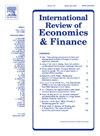An analytic framework for assessing the impacts of physical risk through a (climate-related) expected shortfall
IF 4.8
2区 经济学
Q1 BUSINESS, FINANCE
引用次数: 0
Abstract
This paper introduces a novel measure, that is the climate-related Expected Shortfall, employing a quadratic damage function to capture the nonlinear effects of global warming on economic losses. We find a contrasting geographical pattern: as global warming rises, welfare economic losses in Central Europe (Southern) increase, whilst losses at lower southern latitudes decrease due to the nonlinear effect of climate tipping damage. Additionally, we demonstrate that the ES model is a more coherent measure compared to the VaR model, which lacks the subadditivity axiom and overlooks the “hidden” risks. The results offer a forward-looking tool for regulators and policymakers, enhancing our understanding of practical solutions for measuring climate-related financial risks and encouraging further research in this field.
通过(与气候相关的)预期不足评估物理风险影响的分析框架
本文介绍了一种新的测量方法,即与气候相关的预期损失,它采用二次损害函数来捕捉全球变暖对经济损失的非线性影响。我们发现了一个对比鲜明的地理格局:随着全球变暖的加剧,中欧(南部)的福利经济损失增加,而由于气候突变破坏的非线性效应,南部低纬度地区的损失减少。此外,我们证明了与VaR模型相比,ES模型是一个更连贯的度量,VaR模型缺乏子可加性公理,忽略了“隐藏”风险。研究结果为监管机构和政策制定者提供了前瞻性工具,增强了我们对衡量气候相关金融风险的实际解决方案的理解,并鼓励了该领域的进一步研究。
本文章由计算机程序翻译,如有差异,请以英文原文为准。
求助全文
约1分钟内获得全文
求助全文
来源期刊
CiteScore
7.30
自引率
2.20%
发文量
253
期刊介绍:
The International Review of Economics & Finance (IREF) is a scholarly journal devoted to the publication of high quality theoretical and empirical articles in all areas of international economics, macroeconomics and financial economics. Contributions that facilitate the communications between the real and the financial sectors of the economy are of particular interest.

 求助内容:
求助内容: 应助结果提醒方式:
应助结果提醒方式:


